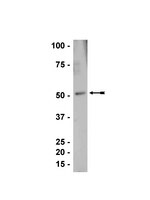Protein expression in Vibrio parahaemolyticus 690 subjected to sublethal heat and ethanol shock treatments.
Ming-Lun Chiang,Wei-Li Ho,Roch-Chui Yu,Cheng-Chun Chou
Journal of food protection
71
2008
Afficher le résumé
Cells of Vibrio parahaemolyticus 690 were subjected either to heat shock at 42 degrees C for 45 min or to ethanol shock in the presence of 5% ethanol for 60 min. The protein profiles of the unstressed and stressed V. parahaemolyticus cells were compared. Additionally, the induction of DnaK- and GroEL-like proteins in the unstressed and stressed cells of V. parahaemolyticus was also examined. Analysis with one-dimensional sodium dodecyl sulfate-polyacrylamide gel electrophoresis (SDS-PAGE) indicated that three proteins with molecular masses of 93, 77, and 58 kDa were induced by both heat shock and ethanol shock. The protein patterns revealed by two-dimensional electrophoresis were more detailed than those revealed by one-dimensional SDS-PAGE. It was found that heat shock and ethanol shock affected the expression of a total of 28 proteins. Among them, four proteins with molecular masses of 94, 32.1, 26.7, and 25.7 kDa were enhanced by both heat shock and ethanol shock. Furthermore, immunoblot analysis showed the presence of a GroEL-like protein with a molecular mass of 61 kDa in the test organism, with the heat-shocked and ethanol-shocked cells producing a GroEL-like protein in a larger quantity than the unstressed cells. However, DnaK-like protein was not detectable in either the unstressed or the stressed cells. | 19044275
 |
Adaptors and linkers in T and B cells.
Simeoni, Luca, et al.
Curr. Opin. Immunol., 16: 304-13 (2004)
2004
Afficher le résumé
By mediating non-covalent protein-protein interactions, adaptors organize and assemble the multimolecular signalling complexes that coordinate intracellular programs leading to the activation and differentiation of lymphocytes. The co-ordinated interaction between adaptor and effector molecules is required for the propagation and dynamic modification of externally applied signals. Recent advances have been made regarding our understanding of how adaptors regulate signalling within lymphocytes. An unexpected function has been revealed for the well-known adaptor protein LAT in pre-B-cell receptor signalling. In addition, the adaptors BCAP, Bcl10, CARMA1 and Malt1 seem to regulate the development of particular B-cell subsets. In contrast to Shc, c-Cbl and LAT, which are involved in early signalling events, BCAP, Bcl10, CARMA1 and Malt1 seem to act more distally, by controlling NF-kappaB activation. Additional transmembrane adaptors, such as NTAL/LAB and LIME, have been identified and partially characterized. Finally, an involvement of the cytosolic adaptors ADAP, SKAP-55 and Cbl-b in the regulation of lymphocyte adhesion and migration has been demonstrated. | 15134779
 |
Hematopoietic adaptors in T-cell signaling: potential applications to transplantation.
Rudd, Christopher E and Wang, Hongyan
Am. J. Transplant., 3: 1204-10 (2003)
2003
Afficher le résumé
Recent advances have been made in understanding the basis of T-cell signaling with the identification of hematopoeitic-specific adaptor proteins, or molecular scaffolds that facilitate protein complex formation and the integration of signals from the surface of T cells. Their potential relevance as targets in the modulation of transplantation relates to their immune-cell-specific expression and their ability to integrate signals needed for T-cell/APC conjugate formation, cytokine production and the clonal expansion of T cells. While LAT, GADS and SLP-76 are needed for TcR-induced cytokine production, the adaptors ADAP, VAV and SKAP-55 play specialized roles in the regulation of integrin adhesion and conjugation. Given the importance of these functions to the reactivity of T cells to allodeterminants of tissue grafts (GvH), and in the recognition and destruction of leukemic cells (GvL), these adaptors represent a new generation of potential targets in the modulation of transplantation. | 14510693
 |
T-cell integrins: more than just sticking points.
Hogg, Nancy, et al.
J. Cell. Sci., 116: 4695-705 (2003)
2003
Afficher le résumé
T cells use integrins in essentially all of their functions. They use integrins to migrate in and out of lymph nodes and, following infection, to migrate into other tissues. At the beginning of an immune response, integrins also participate in the immunological synapse formed between T cells and antigen-presenting cells. Because the ligands for integrins are widely expressed, integrin activity on T cells must be tightly controlled. Integrins become active following signalling through other membrane receptors, which cause both affinity alteration and an increase in integrin clustering. Lipid raft localization may increase integrin activity. Signalling pathways involving ADAP, Vav-1 and SKAP-55, as well as Rap1 and RAPL, cause clustering of leukocyte function-associated antigen-1 (LFA-1; integrin alphaLbeta2). T-cell integrins can also signal, and the pathways dedicated to the migratory activity of T cells have been the most investigated so far. Active LFA-1 causes T-cell attachment and lamellipodial movement induced by myosin light chain kinase at the leading edge, whereas RhoA and ROCK cause T-cell detachment at the trailing edge. Another important signalling pathway acts through CasL/Crk, which might regulate the activity of the GTPases Rac and Rap1 that have important roles in T-cell migration. | 14600256
 |











